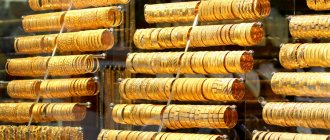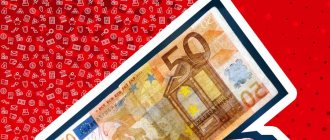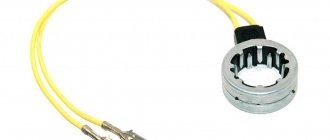Hello! The problem of counterfeit money is quite acute today. And no one wants to lose their money. Today we’ll talk about how to distinguish real euros from fakes.
By purchasing counterfeit currency, a person risks being left without money. Plus, this entails an additional danger if a person suddenly decides to unknowingly pay for goods or services with counterfeit money.
Therefore, when purchasing currency and using it, receiving change in euros, be sure to check each piece of paper for authenticity.
As part of this material, you will learn what series of euro banknotes exist, how they differ, and by what signs you can recognize fraud.
Appearance
Each euro bill has a specific size, motif and main background color. These signs do not relate to security measures, but are the first factor by which these banknotes can be distinguished. The features of Euro banknotes are as follows:
- 5 euros. The main background is gray, the motif is the classical era, parameters are 120x62 mm.
- 10 euros. The bill is made in red and burgundy tones, Romanesque era, dimensions - 127x67mm.
- 20 euros. The predominant shade is blue, the motif is Gothic architecture, the dimensions are 133x72 mm.
- 50 euros. The background color is orange-brown, the motif is Renaissance, dimensions are 140x77 mm.
- 100 euro. The banknote is made in dark green tones, Rococo and Baroque styles, parameters - 147-82 mm.
- 200 euros. The dominant color is yellow, the motif is the era of industrialization, dimensions are 153x82 mm.
- 500 Euro. Main color - purple, 20th century architecture, dimensions - 160x82 mm.
€100
The most widely used banknote. Its design is dominated by green color. The size of the banknote is 147 x 82 mm. In the design of this denomination, the artists used two architectural styles simultaneously: Baroque and Rococo. They date back to the historical period of the 17-18 centuries.
The obverse depicts a powerful arch with columns and statues. On the reverse there is a bridge with several sculptures and a map of Europe.
Determining authenticity by touch
When checking the authenticity of a euro, first of all pay attention to the material. It should be dense and rigid, smooth on one side and rough on the other side. This effect is achieved by producing paper exclusively from cotton fibers.
Some elements, for example, the denomination, inscriptions and the main design must be made into the body; their relief can be clearly felt if you lightly rub the bill with your fingertips or run a fingernail over them. Also on the 200 and 500 euro banknotes there are relief elements for people with visual problems. They are located at the bottom of the 200 euro note and at the right edge of the 500 euro note.
RECOMMENDED: Will the dollar rise and what are the prospects for the ruble?
New series of European currency notes
By the way, the fifty euro banknote is already the third in the new (second) series. The Switzerland Business portal reviews the releases of new series of banknotes of the most popular European currencies. Currently in circulation:
Euro
- New 5 euros;
- New 10 euros;
- New 20 euros;
- New 50 euros.
Swiss frank
The Swiss franc is the legal currency of Switzerland and Liechtenstein . But did you know that francs are also officially used in one other country?
New banknotes in the series: 10 francs / 20 francs / 50 francs / 100 francs / 200 francs / 1000 francs .
British pound
- New 5 pounds;
- New 10 lbs.
Check for light
The easiest way to check banknotes is by holding them up to the light. The watermark is easily visible on the white area; it partially repeats the image on the banknote. There should also be a noticeable number indicating the denomination of the bill and alternating stripes of machine code located vertically.
The denomination, shown in the corner at the top, appears as a collection of individual elements, half of which are printed on one side and the other half on the reverse. When holding the bill up to the light, the parts on both sides fit together perfectly into solid numbers. Also, as if inside the bills, there is a protective tape. In the light it looks like a dark stripe. On it you can make out the inscription “euro” and the denomination.
Authenticity: how to distinguish a fake from a genuine banknote
Counterfeiting banknotes is a problem in almost every state on the planet. Even despite the maximum technological protection of genuine euros from counterfeiting, there are counterfeiters who are capable of producing a fairly high-quality counterfeit. In general, euros are counterfeited about as often as dollars.
Let's take a closer look at the algorithm of actions when checking a banknote for authenticity:
- The first thing you need to check is the inscriptions on the banknote. Real money always has raised inscriptions that can be easily felt with your fingers.
- Already known to everyone, watermarks are not the only protective part; money must also have a security thread running from top to bottom, as well as additional inscriptions.
- Each euro banknote has a holographic inscription or picture, depending on its denomination. If you look at it from a special angle, the appearance of the inscription or picture will begin to change.
If you get your hands on funds from EU countries, make sure they are genuine. This significantly reduces the risk of any questions when trying to pay with cash in retail outlets in Europe.
Hologram and holographic tape
Important signs of the authenticity of the euro are the presence of holographic protection. On banknotes of 5, 10 and 20 euros, the hologram is a silver stripe crossing the banknote across, on which its denomination is distinguishable, surrounded by stars, or the euro symbol. Banknotes of 50, 100, 200 and 500 euros are equipped with a hologram patch. By tilting it at different angles, it can show either the denomination or a composition against a background of circles formed by microscopic text.
The hologram also has micro-perforations, allowing you to determine authenticity with greater confidence. It is noticeable when held up to the light: the tiny holes form the Euro symbol and are made in such a way that if you run your finger or nail over them, it will be impossible to feel them. Banknotes in denominations of 50 euros and above have the denomination of the banknote on the back in the lower right corner. It is applied with a special paint and, as the viewing angle changes, it changes color from purple to greenish-brown or olive.
Authentication using mathematics
See also
: How to distinguish real diamonds from fakes
If you see that all the elements and images seem real, but still doubt the authenticity of the euro, then use the calculator.
Each banknote has its own unique serial number. This code includes a letter and 11 symbols.
For example, let's take a banknote with the conditional serial number S22227803764.
When checking, the resulting amount should be equal to 8.
The verification may take some time. But in the end it gives a 100% authentic result. Or it confirms your fears that it is counterfeit money.
The algorithm is as follows:
- add together all the digits of the serial number;
- in our case it should be 43;
- now to the number 43 add the serial number on which the letter S is located in the alphabet;
- it turns out that you need to add 19 to 43;
- add up the resulting values;
- the number 62 comes out;
- If you add 6 and 2, you get 8.
Such calculations confirm that the euro banknote taken for analysis turned out to be genuine.
In ultraviolet rays
A quick and reliable way to determine whether a banknote is real is to illuminate it with ultraviolet rays. Selective elements of Euro banknotes are applied with phosphors, so that in ultraviolet rays they stand out and change color. On real banknotes:
- the base paper does not react to light and remains dark;
- security threads on the paper are arranged in a chaotic manner and are illuminated in blue, red and green;
- the European Union flag and stars stand out. The flag acquires a green glow, the stars - orange;
- the personal signature of the EBU chairman changes its shade towards greenish;
- the ring and stars glow on the front;
- on the back side the bridge, card and denomination should be highlighted in rich yellow.
Design Features
It was mentioned above that EU banknotes are designed in a single architectural and schematic style. Their authors used in their design all the architectural styles characteristic of the territories of the European Union. They keep records from the ancient period to the present time. On the front side of the banknote there are gates, windows or facades corresponding to a certain era and its architectural style. On the reverse side is a bridge built in the same style.
Gates (windows) and bridges on all paper denominations create community, unity of design. It was no coincidence that the creators used these two images - they have a deep meaning. The gates symbolize the openness of the EU zone to foreign partners, and the bridges symbolize the willingness to negotiate and cooperate, so to speak, “building bridges.”
Paper money comes in different sizes: the smaller the denomination, the smaller the size. If you compare the size of the smallest 5€ note with the largest 500€ note, the difference in size is 4 cm.
The design of each paper banknote contains the following elements:
- EU flag and map.
- 12 stars.
- “ECB” is an abbreviation written in 5 languages.
- The name of the Euro currency is in 2 or 3 languages, depending on the year the bill was issued.
- Signature of the head of the ECB.
Date of appearance in Switzerland and CIS countries
There is no release date for the new 50 euros outside the eurozone (for example, in Switzerland, Russia, Ukraine, etc.). However, local banks that receive cash euro banknotes from the ECB (or on its behalf from the central banks of eurozone member countries) will in future only be supplied with quantities of the new series. Accordingly, over time, customers will be able to buy a banknote of the new series.
Whether it is possible to exchange old 50 euros for new ones in Russian banks and CIS credit institutions is determined by each bank individually. There is no legal exchange obligation for finance houses outside the eurozone. Accordingly, any Russian (Ukrainian, Kazakh, etc.) bank is not obliged to accept old samples from you.
Find out also:
- Which banknote is recognized as the most beautiful in the world?
- In what currencies is it recommended to keep savings?
- What does it mean that Swiss francs will become unlimited?
What to do with old 50 euros?
With the release of the new 50 euro note, its predecessor still retains its nominal value. Old banknotes will continue to be accepted as everyday currency without any time limits.
Bankers expect that the new bill will quickly land in the hands of Europeans without any associated problems - commercial banks and other institutional bodies of the Eurozone are ready to contribute to this.
We will be able to find out how the new 50 euro note will actually manifest itself in 2-3 months, when the banknote is fully established in mass circulation.
Popular with counterfeiters
The 50 euro note is the most used banknote throughout the eurozone, accounting for almost 50 percent of all banknotes in circulation.
At the same time, it is also the most popular among counterfeiters. In 2016, it accounted for 61 percent of all counterfeit euros in mass circulation - approximately 82,200 counterfeit banknotes.
The European Central Bank hopes that new security features such as watermarks, ribbed edges and holograms will make the new banknotes more difficult to counterfeit. Ideally, make it impossible.
Euro symbol
The date of birth of the graphic sign of the common European currency is December 12, 1996. It looks like a combination of the Greek letter epsilon - an indicator of the strength and significance of European civilization, the Latin E, symbolizing Europe, and 2 horizontal lines crossing it, emphasizing the stability of the euro.
The euro symbol was invented in 1996.
Banknotes in circulation
Euro money comes in the form of banknotes and coins. Paper banknotes are available in seven denominations: 5, 10, 20, 50, 100, 200, 500 euros. Eight types of coins are changeable 1, 2, 5, 10, 20, 50 cents, and there are also 2 and 1 euro. All types of cash are made in the same style. The notes display European architectural elements tracing their progress.
Banknotes were first issued in 2002. In 2013, the second series entitled “Europe” was released. It is characterized by minor but clearly distinguishable design changes and modern security elements. According to the ECB's intentions, new money will be issued into circulation every 7 or 8 years. The style and thematic focus of the images remained the same.
5 euros
The 5 euro note has the smallest denomination of all existing euro money and a correspondingly small size of 120 by 62 mm. The appearance is distinguished by gray shades. Ancient architecture is visible: the temple portal depicted on the front side (obverse), a two-tier bridge on the back (reverse). There is a 5 euro note from 2013, which was reissued with the “Europe” series.
The protection is represented by a watermark with an image of an arch and a number. On the left there is a security thread on which “5 EURO” is read. The front side is equipped with a holographic tape, on which, when turned, a euro sign, the number 5, and an inscription with the name in Greek and Latin appear.
10 euros
The second largest banknote is red or slightly pink in color. Dimensions 10 euros – 127 by 67 mm. What is depicted on it reflects the medieval era: the castle portal on the front and the stone bridge on the back. The appearance of a new euro banknote with improvements dates back to 2014. The watermark shows an arch and the number 10. The security thread has the inscription “10 EURO”, the hologram shows the euro sign and the denomination. The background under ultraviolet light becomes dark, the stars orange, and the bridge green in hue.
20 euros
The blue denomination has even larger dimensions: 133 by 72 mm. Architectural motifs are represented in the Gothic style. These are pointed arched windows on the front side and a stone bridge on the reverse. The release of the new version dates back to 2015. The 20 euro security is made in the form of a vertical thread, holographic tape and watermarks.
50 euros
The orange 50 euro (€50) note measures 140 by 77 mm. It depicts Renaissance architecture: a Renaissance window opening and a bridge. In 2022, an updated 50 euro note appeared with enhanced security. The watermark shows the goddess Europa. There is a hologram, thread, ultraviolet ink, perforation, microprinting are used. The serial number is subject to a mathematical rule.
The name 50 euros in the European Union is also printed in Cyrillic, because Bulgaria joined it. The denomination can be felt, which is made for visually impaired people. The 50 euro banknote is very popular. It makes up 45% of all those in circulation in the EU. There are 2 options from different production series. For genuine money, the paper should not be smooth; watermarks are visible in the light, although there are high-quality imitations of them. Only the 50 euro note has the property that the transparent strip on the back turns golden in reflected light. Negative inscriptions 50 and € appear on it.
100 euro
One of the largest banknotes in denomination “one hundred” is 147 by 82 mm in size and includes two architectural styles: Baroque and Rococo. The green 100 euro note has a portal with Atlantean statues on the obverse and a bridge with sculptures on the reverse. The banknote's appearance is marked by the traditional 12-star symbol, the flag, the map and the signature of the EU director. The watermark contains an arch and is visible in light from both sides. There is also a hologram and the inscription “100 EUR” on the security thread. Like other large banknotes, there are characteristic security features that prevent counterfeiting. This is a matte texture, perforation, microprinting, parts of the number 100 are combined.
200 euros
The yellow bill measures 153 by 82 mm and has matte images, perforations and microprinting. At the bottom of the obverse of 200 euros there are vertical relief features so that authenticity can be determined tactilely. The way this money looks is close to the modern era. This is modern, architecture using steel and glass. On the front side there are glass portals, on the back there is a metal bridge and a map. There is a security thread and watermarks.
500 Euro
The banknote of the highest denomination with a size of 160 by 82 mm is painted in purple shades, reflecting modernity. On the front side there is a skyscraper made of glass and concrete. On the back are suspension bridges. Since 2016, the issue of 500 euros has been discontinued, but it is possible to resume it with the “Europe” series.
The question of how to determine authenticity is resolved by a watermark on which the denomination is visible and a hologram.
There are also colored fibers, microtext, and relief.
EU Bank
The main functions in the field of regulation of the Euro belong to the Central Bank of Europe, formed in June 1998. The main office is located in Frankfurt. The leadership consists of representatives of all countries of the union. The signature of the Bank's director is reflected on each banknote. The director is elected every 8 years. It is now led by Mario Draghi since 2011. Main functions of the bank:
- development and implementation of foreign exchange regulation policy in the EU;
- regulation and control over the content of monetary reserves of the European Union countries;
- issue of cash;
- establishing current rates;
- management in the field of stability of the price range of Euro countries. The inflation rate remains around 2%.
Anniversary and commemorative money
The most common commemorative coin is the 2 euro denomination (more than 300 types have been issued). Each state can create its own souvenirs depicting important events. There are general series on a single topic. All this money is a means of payment and also has a collectible value. Commemorative coins made of precious metals differ from memorable souvenirs. 4 episodes were released.
- In 2007, 13 coins "Treaty of Rome".
- 2009 – 16 coins “10 years of the Economic and Monetary Union”.
- 2012 – 17 coins “10 years of the euro”.
- 2015 – 19 coins “30 years of the European flag”.
States may produce commemorative items in entire series. Germany dedicated the issue to the Federal States, and Spain – to cultural and natural monuments of UNESCO. There is also a feature related to 5 euros. The coin is suitable for payment only in the country where it was issued, but more often remains in collections.
The issuance of souvenir banknotes is not practiced, but there are non-payment copies for collections. This is how 0 euros were produced with all security elements. Or denominations of 300, 600, 1000, endowed with erotic content and the name EROS. It was funny that store clerks in some cities accepted them.
Coins
Coins starting from 1 cent are in circulation. Next come 2, 5, 10, 20 and 50 cents. There are also 1 and 2 euros. All coins are united by a common image of a number against the background of a European map, made schematically. It is surrounded by 12 stars, to which parallel straight lines are drawn. The 1, 2, and 5 cents show Europe on the world map. At 10, 20 and 50 cents, European countries are shown separately. The 1 and 2 euro coins reflect the unified EU map without borders.
On the reverse there is an element of the country where the coin was made. This feature does not prevent the use of coins in other countries with Euro currency. The coin has an edge that helps people with low vision establish its value.
Coins from 1 to 5 cents are made of steel and copper plated. They have a reddish tint. The denominations 10, 20 and 50 are distinguished by their yellow color. Nordic Gold metal was used for their minting. 1 and 2 Euro are characterized by a design combination of two shades: white and yellow. Nickel alloys and alloys with the addition of copper and zinc are used for manufacturing. Bimetal is used to prevent counterfeiting. Text has been added to the edge of the 2 Euro coin, varying depending on the country of origin.
The denomination of the 2 Euro banknote is often used for minting commemorative coins. The obverse does not differ from the usual sample. The reverse may depict famous personalities and representatives of the plant world. The price of such coins is always significantly higher, since the composition includes precious metals, and the issue is very limited.
The main signs of a fake
Each type of Eurobanknote has a unique design and security features, the altered appearance or absence of which indicates falsification. In most cases, counterfeit 500 euro banknotes are identified by 4 features: low quality paper, relief print, watermark and holographic image.
| Characteristic | Sign of a fake |
| Paper quality | Excessive softness of the material and lack of a characteristic crunch when crushed |
| Method of creating filigree | A printed watermark that becomes darker than the surrounding light space |
| Properties of a hologram | Static image when tilting the bill |
| Embossed line with the abbreviation ECB | No bulges where ink is applied |











